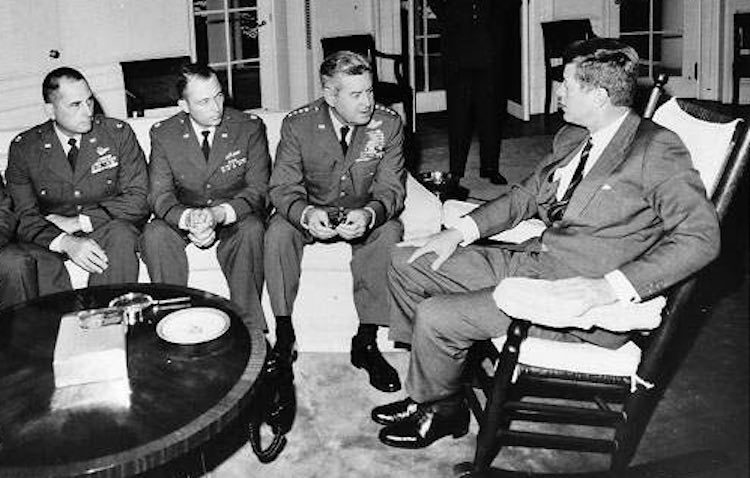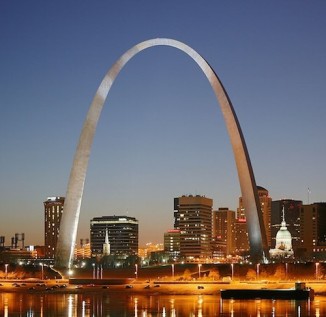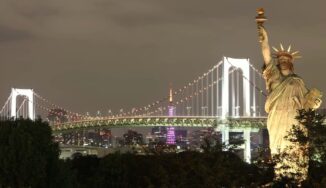61 years ago today, the whole world breathed a sigh of relief as the Cuban Missile Crisis ended with Soviet Union leader Nikita Khrushchev agreeing to dismantle his missiles in Cuba in exchange for Kennedy’s promise to remove NATO missiles from Turkey and Italy. With the current risk of nuclear war in Ukraine, it’s important to remember that Russia and the U.S. have crossed these seas before. WATCH an animated recap of the 6 days that saved the world… (1962)

For starters, ExComm had presented President Kennedy with three plans to deal with the missiles on Cuba, one of which involved erasing it from the map with nuclear weapons. The second was a full-scale combined arms invasion, and the third, which Kennedy selected, was described as a “limited action for a limited purpose,” namely the prevention of further installation of missiles on the island through a blockade.
Subsequent histories, including audio records made of the ExComm meetings secretly by Robert Kennedy, have revealed that the pressure on Kennedy to launch a nuclear first strike was immense. Eventually, Diplomatic efforts behind the scenes between a Kremlin official and Robert Kennedy led to the USSR decision to pull out and ease tensions.
More Good News on this Date:
- Gulliver’s Travels by Jonathan Swift is published in London (1726)
- Thomas Edison applied for his first patent, an electrical vote recorder (1868)
- New Yorkers spontaneously invented a ticker-tape parade as office workers threw ticker tape into the streets as the Statue of Liberty was dedicated (1886)
- Czechoslovakia was granted independence from Austria-Hungary (1918)
- The Alaska (AlCan) Highway was completed through Canada and Alaska (1942)
- The Nobel Prize for Literature was awarded to Ernest Hemingway for his “mastery of the art of narrative, most recently demonstrated in The Old Man and the Sea, and for the influence that he has exerted on contemporary style” (1954)
- Cristina Fernandez became the first woman elected President of Argentina (2007)
And, on this day in 1965, the Gateway Arch in St. Louis, Missouri was completed. Clad in stainless steel and standing 630 feet high, it is the tallest monument in the Western Hemisphere.

The arch sits on the west bank of the Mississippi River as a tribute to the great westward explorers, Lewis and Clark, and other pioneers who began treks in St. Louis. The architect, Eero Saarinen, designed the arch to sway a full 18 inches, with a hollow interior where four million tourists could visit every year and gaze through high windows above the city.
Today is the 83rd anniversary of the day when Greece replied to outside Fascist demands with an emphatic ‘NO’. It commemorates the rejection by Greek prime minister Ioannis Metaxas following the ultimatum given at three o’clock in the morning by the Italian dictator Mussolini: ‘Give the Axis powers strategic access to your land for occupation, or face war. The story goes that Greece’s answer was one single word: ‘Oxi’. (No!)

Greece then fought off the invading Italian forces at the Albanian border—the very first setback for the Nazi-Fascists in World War II. The myth of their invincibility was broken. Such a small country standing up to the demands of the Axis powers was the first good news in the early days of the war. Later that morning on October 28, the Greek population took to the streets, irrespective of political affiliation, shouting ‘ohi’ (or, oxi). FDR, Stalin, Churchill—and even Hitler—all hailed the Greeks for their courageous resistance. Oxi Day is now a national holiday. WATCH a video.. (1940)
137 years ago today, the Statue of Liberty was officially unveiled and opened to the public in New York Harbor. A gift to the United States from the people of France, the statue was envisioned by a French professor who wanted to honor the American Revolution and also to spark a similar democratic movement in France.

Officially named Liberty Enlightening the World, the sculpture is a robed female figure representing Libertas, a Roman goddess, who holds a tablet inscribed with the date of the American Declaration of Independence—July 4, 1776.

A broken chain lies at her feet symbolizing a move away from slavery. Often called “Lady Liberty”, it was a welcoming sight to thousands of immigrants arriving from abroad. CHECK out four fun facts… (1886)
– PHOTO CREDITS: (top) Ronile, CC License; (bottom) kazuend
- The statue originally was used until 1901 as a lighthouse, to signal boats up to 24 miles away.
- On D-Day in 1944, the crown flashed the Morse code equivalent (dot-dot-dot-dash) of “V” for victory by the Allied Forces.
- The statues is believed to be struck by lightning an average of 600 times each year.
- On the morning of the dedication, a parade was held in New York City, and as it passed by the New York Stock Exchange, traders spontaneously threw ticker tape from the windows, launching a Big Apple tradition for celebrating parades.
SHARE the Memories and Milestones of History…




















[…] post Good News in History, October 28 appeared first on The Good News […]
[…] By Good News Network […]
[…] The Good News Network […]